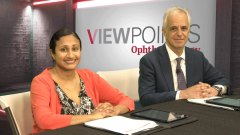
Key Takeaways on Managing Neovascular AMD and DME
Nathan Steinle, MD; Adrienne Scott, MD; Carl Regillo, MD, FACS, FASRS; and Prethy Rao, MD, MPH, share final thoughts on the changing treatment landscape of neovascular AMD and DME.
Episodes in this series

Nathan Steinle, MD: Thanks to all of you for this very informed discussion. Before we conclude, I’d like to get final thoughts from each of you. Dr Adrienne Scott?
Adrienne Scott, MD: I think it’s an amazing time to be a retina specialist. I’m at a point in my career where I can remember when all we had were certain laser treatments and photodynamic therapy and just hoped a patient didn’t lose vision or hoped we could slow their vision loss. Now it’s exciting that we seem to have this wealth of things in our armamentarium to offer patients. But the jury’s still out, and then the ultimate elephant in all our rooms is the insurance payers and the ultimate cost to the health care systems with all these different products. But it’s an exciting time. I’m thrilled to be practicing with so many choices.
Nathan Steinle, MD: Final thoughts, Dr Regillo?
Carl Regillo, MD, FACS, FASRS: I’ve been practicing retina care longer than anyone here on this panel. And I’ve lived the bad old days of managing these common vision-threatening and blinding disorders pre-anti-VEGF [anti–vascular endothelial growth factor therapy] here, and the world is a lot better right now. And we’re continuing to make very good progress at a very good rate. Obviously, when anti-VEGFs hit the scene, it was a major transformation in helping our patients, and we’re still doing better. It seems like every year or two we get either a new therapy or a new approach or thinking that improves our patients’ quality of life, and that’s very exciting. I think we’re going to continue to make great progress in the future.
Nathan Steinle, MD: Dr Rao?
Prethy Rao, MD, MPH: On the opposite side of the spectrum, as a young retina specialist, I would say it’s an exciting time because we have multiple dynamic plays in effect. We have reference drugs that have been on the market for almost 10 years now. We have biosimilar agents that are being introduced to rival or complement these reference drugs. We have gene therapy, which hopefully will transform how we treat in terms of treatment burden. On top of that, we have this AI [artificial intelligence], big-data component. So, as a young retina specialist, having these different avenues to be able to look at the field is very inspiring, and I think it inspires young retina specialists to go into the field.
Nathan Steinle, MD: Thank you for watching this Modern RetinaTM Viewpoints. If you’ve enjoyed the content, please subscribe to our e-newsletters to receive upcoming viewpoints and other great content right in your inbox.
Transcript edited for clarity
Newsletter
Keep your retina practice on the forefront—subscribe for expert analysis and emerging trends in retinal disease management.



















































